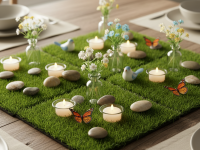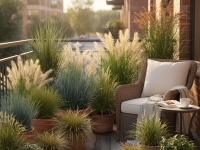Picture this: a warm summer evening, a gentle breeze, and you, relaxing on a beautiful, sturdy piece of outdoor furniture. It’s not just any furniture; it’s made from hardwood, crafted to withstand the elements and look stuing for years. But here’s the million-dollar question: how do you pick the right hardwood species from the dizzying array of options out there, especially when you’re looking for something that truly thrives in the diverse climates of the USA?
If you’ve ever felt overwhelmed by terms like “Teak,” “Ipe,” “Eucalyptus,” or “White Oak” when shopping for outdoor furniture, you’re not alone. I’ve been there, staring at samples, trying to decode the jargon, and worrying about making an expensive mistake. That’s why I put together this guide – to share what I’ve learned through my own experiences and research, helping you make an informed decision that you’ll love for seasons to come. We’ll dive deep into the world of hardwoods, focusing on durability, aesthetics, maintenance, and how they perform specifically in the American environment.
Why Hardwood for Outdoor Furniture?
Before we jump into specific species, let’s quickly touch on why hardwood is often the go-to choice for premium outdoor furniture. Unlike softer woods or synthetics, hardwoods generally offer superior density, strength, and natural resistance to rot, decay, and insect infestation. This translates into furniture that lasts longer, requires less frequent replacement, and often develops a beautiful, rich patina over time – truly an investment in your outdoor living space.
Key Factors to Consider When Choosing Hardwood for Outdoors
Choosing the perfect hardwood isn’t just about picking a nice color. It’s a strategic decision that balances several crucial factors. Think of it like a puzzle where all the pieces need to fit your lifestyle, climate, and aesthetic preferences.
Durability and Weather Resistance: Your Furniture’s First Line of Defense
This is arguably the most critical factor for outdoor furniture. We’re talking about wood that needs to stand up to everything Mother Nature throws at it: scorching sun, torrential rain, freezing snow, and even hungry insects. Here’s what to look for:
- Natural Oils and Resins: Woods rich in these are inherently resistant to moisture, rot, and fungi.
- Density: Denser woods are generally stronger and more resistant to impacts, scratches, and warping.
- Stability: How well does the wood hold its shape when exposed to changes in humidity and temperature? Woods that are prone to excessive expansion and contraction can crack or warp over time.
- Insect Resistance: Some woods naturally deter pests like termites and borers, which is a huge plus.
Aesthetics: What Look Are You Going For?
Your outdoor furniture should complement your home and garden. Hardwoods offer a stuing range of natural colors and grain patterns. Do you prefer a classic, golden hue that gradually silvers, or a deep, rich brown that stays consistent with regular oiling? Consider:
- Natural Color: From pale yellows to rich reds and deep browns.
- Grain Pattern: Some woods have a tight, straight grain, while others boast more dramatic, swirling patterns.
- Aging Process: Most hardwoods will develop a silver-gray patina if left untreated. Do you love this weathered look, or do you prefer to maintain the original color with regular maintenance?
Maintenance: How Much TLC Are You Willing to Give?
Let’s be honest, we all have different levels of enthusiasm for DIY projects. Outdoor hardwood furniture typically falls into two camps: those you let age gracefully, and those you regularly oil or seal to preserve their original look. Ask yourself:
- “Set It and Forget It” vs. Regular Upkeep: Are you okay with a silver patina and minimal fuss, or do you prefer the vibrant color that comes with aual (or semi-aual) oiling?
- Cleaning: All outdoor furniture will need occasional cleaning to remove dirt, pollen, and mildew.
- Winter Storage: While many hardwoods are tough, extending their lifespan often involves covering them or storing them indoors during harsh winter months.
Budget: Quality Comes at a Price (Sometimes)
Outdoor hardwood furniture is an investment. Prices vary significantly between species, reflecting their rarity, sourcing, and processing difficulty. While it might be tempting to go for the cheapest option, remember that durability often correlates with price. A higher initial investment in a top-tier wood might save you money in the long run by avoiding replacements.
Sustainability and Sourcing: A Conscience Choice
For many of us, knowing where our materials come from is important. When choosing hardwood, especially imported species, look for:
- FSC Certification: The Forest Stewardship Council (FSC) label indicates that the wood comes from responsibly managed forests.
- Local Sourcing: Opting for domestically grown hardwoods can reduce carbon footprint and support local industries.
Top Hardwood Species for Outdoor Furniture in the USA
Now, let’s get to the stars of the show – the hardwood species that truly shine outdoors. Keep in mind that performance can vary based on the specific climate zone within the USA, but these are generally excellent choices.
Teak: The Gold Standard
Ah, Teak. Often hailed as the king of outdoor woods, and for good reason. Originating from Southeast Asia, Teak (Tectona grandis) is renowned for its exceptional durability and beauty. Its high concentration of natural oils and rubber makes it virtually impervious to water, rot, fungi, and insects. I’ve seen teak furniture last for decades, even in demanding coastal environments.
- Pros: Unrivaled durability, stability, natural insect/rot resistance, beautiful golden-brown color that patinas to an elegant silver.
- Cons: High price point due to slow growth and demand, sourcing can be a concern if not FSC certified.
- Maintenance: Minimal. Can be left untreated to silver, or oiled aually to maintain its golden hue. Regular cleaning is sufficient.
Ipe (Brazilian Walnut): The Indestructible Challenger
If Teak is king, Ipe (pronounced “ee-pay”) is its formidable rival. Hailing from South America, Ipe is incredibly dense, hard, and boasts an impressive dark brown color. It’s so dense, it barely floats! Often used for decking and boardwalks (like the Coney Island Boardwalk), it’s built to last.
- Pros: Extreme hardness and density, superior rot and insect resistance, very long lifespan, rich deep brown color.
- Cons: Very expensive, extremely heavy and hard to work with (making furniture costly), can be prone to surface checking (fine cracks) if not properly dried/maintained. Can get very hot in direct sun.
- Maintenance: Similar to Teak. Can be left to weather to silver or oiled to retain its dark color.
Shorea (Red Balau): Teak’s More Affordable Cousin
Shorea is a generic name for a group of tropical hardwoods from Southeast Asia, with Red Balau being a common variety used for outdoor furniture. It shares many characteristics with Teak but typically comes at a more approachable price point.
- Pros: Good density and durability, natural resistance to rot and insects, attractive reddish-brown color, more affordable than Teak or Ipe.
- Cons: Can be prone to surface checking, not quite as stable or rot-resistant as Teak, requires good drainage.
- Maintenance: Benefits from regular oiling to maintain its color and prevent excessive checking.
Eucalyptus: The Fast-Growing & Eco-Friendly Option
Eucalyptus, primarily grown in sustainable plantations around the world, is an increasingly popular choice for outdoor furniture. It’s a fast-growing hardwood, making it a more environmentally friendly option. It has a beautiful reddish-brown hue and a straight, appealing grain.
- Pros: More sustainable and often more affordable than tropical hardwoods, good strength and density, attractive color.
- Cons: Not as naturally rot-resistant or stable as Teak; requires more consistent maintenance (oiling) to prevent cracking, fading, and maintain its look.
- Maintenance: Requires regular oiling (at least aually, sometimes twice a year depending on climate) to keep it from drying out, cracking, and fading.
White Oak: A North American Classic
If you’re looking for a domestically sourced option, White Oak (Quercus alba) is an excellent choice. It’s known for its strength, durability, and resistance to rot, thanks to its closed cellular structure which makes it highly impermeable to water. This is why it’s historically been used for boat building and whiskey barrels!
- Pros: Domestically sourced (often FSC certified), excellent strength and stability, good natural rot resistance, beautiful light to medium brown color with a prominent grain.
- Cons: Heavier than some other options, can be more expensive than Eucalyptus, needs a good finish for optimal outdoor performance.
- Maintenance: Best protected with a quality outdoor-specific oil or sealant, especially if you want to maintain its color and prevent weathering.
Black Locust: The Hidden Gem
Often overlooked, Black Locust (Robinia pseudoacacia) is a native North American hardwood that deserves serious consideration. It’s incredibly dense, durable, and naturally resistant to rot and insects – often outperforming even White Oak in these areas. It’s so tough, it’s used for fence posts and vineyard stakes without any treatment.
- Pros: Extremely rot and insect resistant (one of the best), very dense and durable, beautiful yellowish-green to golden-brown color, naturally sourced in the USA.
- Cons: Can be hard to find in furniture-grade lumber, very heavy and hard to work with (like Ipe), can check and crack if not properly dried.
- Maintenance: Can be left untreated to weather to a gray, or occasionally oiled for color retention. Minimal upkeep needed for durability.
Finishing Your Outdoor Hardwood Furniture
Once you’ve chosen your wood, the final step is deciding on a finish. This significantly impacts both the look and the longevity of your furniture.
Oil-Based Finishes: Enhancing Natural Beauty
Many people opt for penetrating oil finishes (like Teak oil, linseed oil, or tung oil) because they soak into the wood, nourishing it from within and enhancing its natural color and grain. This is my preferred method for Teak and Eucalyptus.
- Pros: Easy to apply, brings out wood’s natural beauty, allows wood to breathe, helps prevent drying and cracking.
- Cons: Requires regular reapplication (aually or bi-aually), offers less surface protection against spills and scratches than film-forming finishes.
Sealers and Varnishes: For Maximum Protection
These are film-forming finishes that sit on the surface of the wood, creating a protective barrier against moisture, UV rays, and abrasion. Often used for woods like White Oak or Eucalyptus when you want a highly protected, consistent look.
- Pros: Excellent protection against elements, less frequent reapplication than oils, can provide a glossy or satin look.
- Cons: Can peel or crack over time, requiring sanding before reapplication; can obscure the natural feel of the wood.
The “No Finish” Approach: Embracing the Patina
For hardwoods like Teak, Ipe, and Black Locust, you can absolutely choose to apply no finish at all. These woods are so naturally resilient that they’ll simply weather to a beautiful silver-gray patina over time. It’s a low-maintenance, elegant look that many outdoor furniture enthusiasts adore.
- Pros: Zero maintenance for color (just cleaning), natural weathered aesthetic, wood breathes completely.
- Cons: Not suitable for all wood types (some will crack/warp without protection), color changes significantly from original.
Conclusion
Choosing the right hardwood for your outdoor furniture in the USA is a journey, not a sprint. It’s about weighing durability against aesthetics, maintenance against budget, and ultimately, finding a wood that will bring you joy and comfort for years to come. Whether you opt for the legendary resilience of Teak, the sustainable charm of Eucalyptus, or the homegrown strength of White Oak, rest assured that a well-chosen hardwood will elevate your outdoor living space like no other material.
Take your time, consider your local climate, and think about how much “TLC” you’re willing to give. With this knowledge, you’re now equipped to make a choice that’s not just beautiful, but truly built to last. Go forth and create your perfect outdoor oasis!



